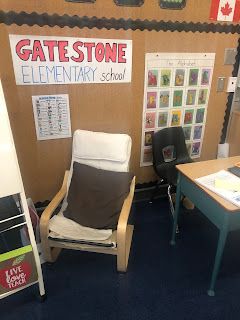Whoops! I missed some of these pictures from last week :)
Wednesday, 29 January 2020
Literacy: Syllables!
This week we are practising hearing the syllables inside of words! We will sometimes call them "beats", or the "big" sounds in words. Syllables can sometimes be confusing for kids. They can sometimes add extra syllables in words that aren't there (i.e., saying the word house has 2, h-ouse). I redirect them to use the word in a sentence, or clapping it out. Sometimes students can get confused between syllables and segmenting. That means, for example, they think the word cat has 3 syllables, c-a-t, when in reality it only has 1, but has 3 sounds.
We started by practicing clapping the syllables in our name :) Most of our friends have 3... some have 2, and some even have 1! You can play a game at home with your family by practising everyone's name. Understanding syllables is important because it will help with the transition of spelling. We have to be able to identify the syllables in words, so we can then segment each syllable and spell it out. I made a quick chart below to explain.
We started by practicing clapping the syllables in our name :) Most of our friends have 3... some have 2, and some even have 1! You can play a game at home with your family by practising everyone's name. Understanding syllables is important because it will help with the transition of spelling. We have to be able to identify the syllables in words, so we can then segment each syllable and spell it out. I made a quick chart below to explain.
By the end of SK, I would expect students to be able to spell simple, 1 syllable CVC (consonant vowel consonant) words.... real or nonsense, such as cat, dog, yed, soc. I would also expect them to be able to clap the beats in words up to 3/4 syllables. Some of our SKs sat down with me to play a game of "Syllable Smash"! It was fun! We also watched this fun video about syllables :)
Wednesday, 22 January 2020
Literacy: Special Letters!
To celebrate knowing our special letters, we made some crafts this week using them! We've also been practising learning beginning sounds in words. A fun activity to do at home would be to make an alliterative sentence using your child's name and their craft! For example, Sally liked to sing with silly snakes. If your child is past this, they can try writing their sentence down! We will be starting some small groups soon to continue to practise our literacy skills :)
Tuesday, 21 January 2020
Mathematics: Learning Quantity with Number Racks!
Yesterday we introduced something called a number rack! It's a very important tool we use in Kindergarten. We're using a 20 number rack, but you can have one that goes all the way up to 100. It's kind of like an abacus, but a bit more fine tuned ;) Each rod has 10 beads on it, 5 red and 5 white. We started by learning about how to use it, and then played a game of "How many?'. I would push some over and they would have to see how many there were. Watch this video I made ions ago to learn more about how we use it!
There are apps you can download on the iPad (search rekenrek) or you can make one out of cardboard, pipe cleaners, and beads. Number racks have the following benefits:
- when numbers get larger, so does the quantity
- understand the important of 5 and 10 as benchmarks (instantly recognizing 5, pulling 2 more over and knowing that that's 7)
- different ways to compose numbers (1 and 9 make 10, so does 8 and 2, etc.)
- addition
- more or less than
- place value (15 is actually 10 and 5 more)
We will continue to explore this math tool during our daily math time :)
Friday, 17 January 2020
Thursday, 16 January 2020
Mathematics: Subitizing Fun!
In Kindergarten, we love to subitize! Subitizing (soo-ba-tizing) is recognizing a quantity without counting. It's easier to subitize smaller quantities, or quantities that are in some type of pattern. The kids have become really good at it! Here are a couple of our favourite subitizing videos that you can watch at home :) The kids know what the word subitize means... not that it's important, but it's just a part of the song ;)
Why is knowing how to subitize important? It's attaches the quantity of a number to the numeral, and it's the perfect way to transition into addition. Subitizing goes hand in hand with counting on (starting at a number and counting on, instead of counting from 1 again). Once we acquire these two skills, it's makes adding easy! We can also maneuver dots or objects in our head, which actually leads to regrouping!
For example, one of our student's thought process for adding these was:
"I know that's 9, if I move 1 dot over here, it makes 10, which is 10 and 1, which I know is 11!".
Why is knowing how to subitize important? It's attaches the quantity of a number to the numeral, and it's the perfect way to transition into addition. Subitizing goes hand in hand with counting on (starting at a number and counting on, instead of counting from 1 again). Once we acquire these two skills, it's makes adding easy! We can also maneuver dots or objects in our head, which actually leads to regrouping!
For example, one of our student's thought process for adding these was:
"I know that's 9, if I move 1 dot over here, it makes 10, which is 10 and 1, which I know is 11!".
Watch one of our students perfect their subitizing skills below!
Wednesday, 15 January 2020
Special Events: Movie and Popcorn Party!
We celebrated achieving 10 hearts on our chart with a movie and popcorn party! The students voted on watching Wreck it Ralph. We had so much fun! :)
Our Current Inquiry: Gatestone Elementary School!
As Santa's Workshop made its exit, our play school/classroom area came to fruition! The students have always enjoyed playing "teacher", so we made our own classroom! We attached it to dramatic play so students can pack their lunch and backpacks at "home", or the teacher can make some coffee before work ;) Expect lots of pictures shortly! :)
Literacy: Sorting Sounds!
On Friday we played a game where we sorted sounds by short sounds and continuous sounds. Some sounds, like the sound that s makes, is a continuous sound, because you can keep making it, whereas the sound p makes is a short sound. Try playing this game at home!
Subscribe to:
Comments (Atom)





















































